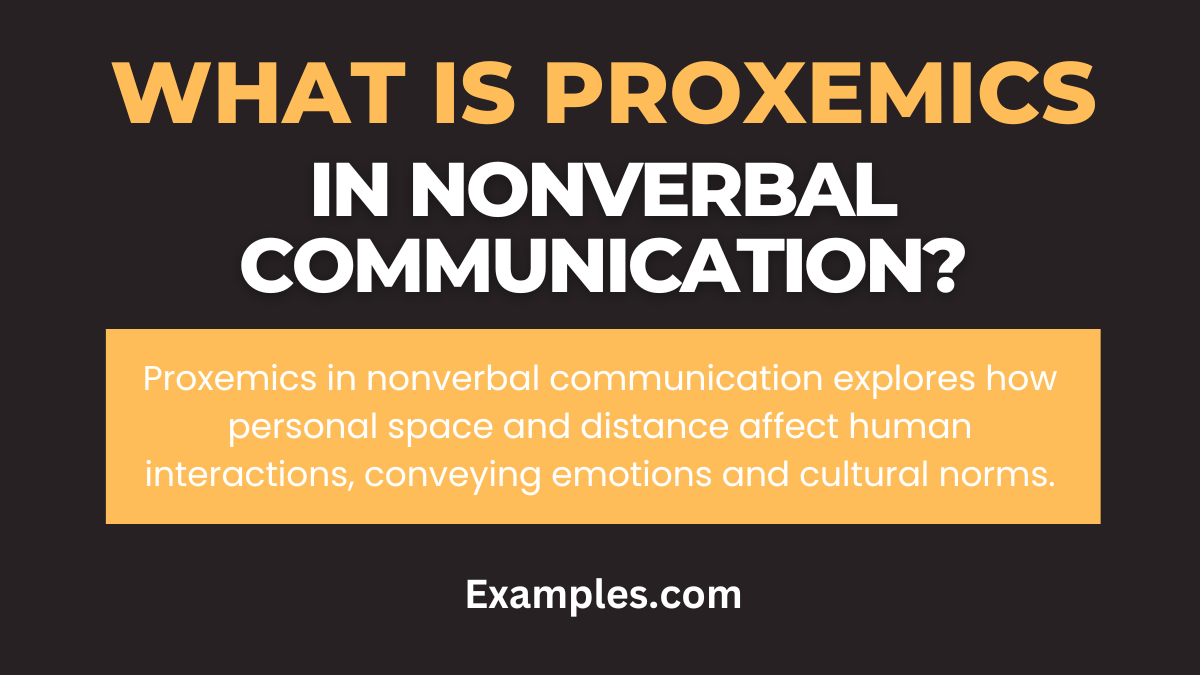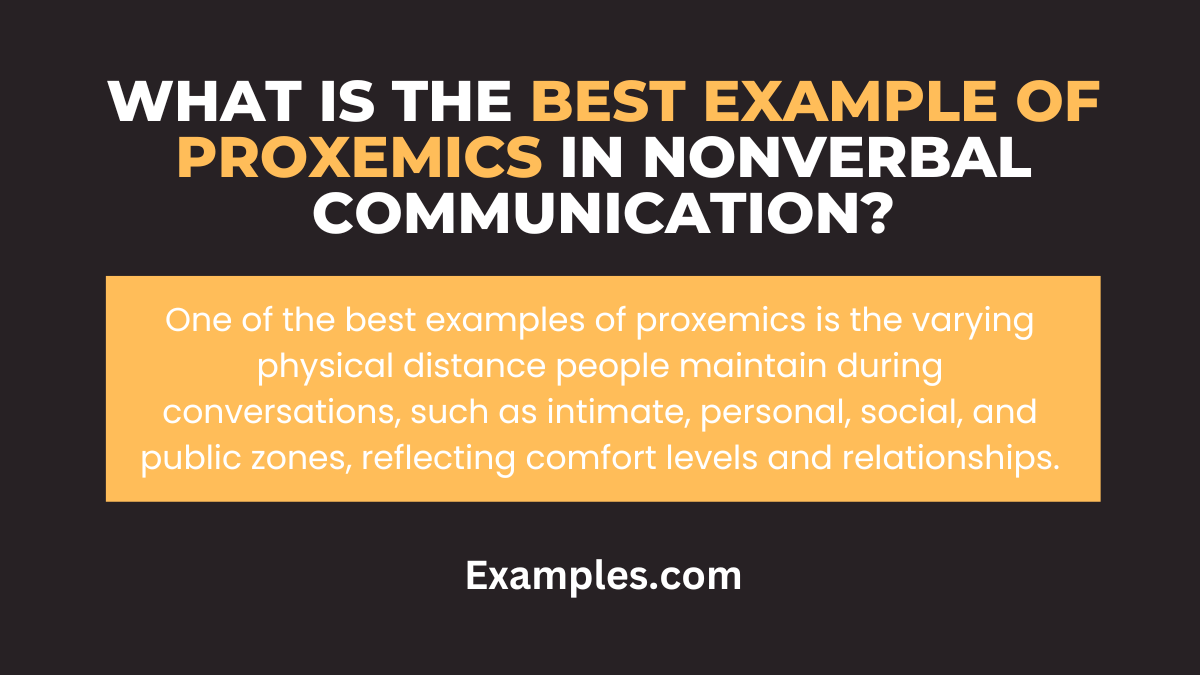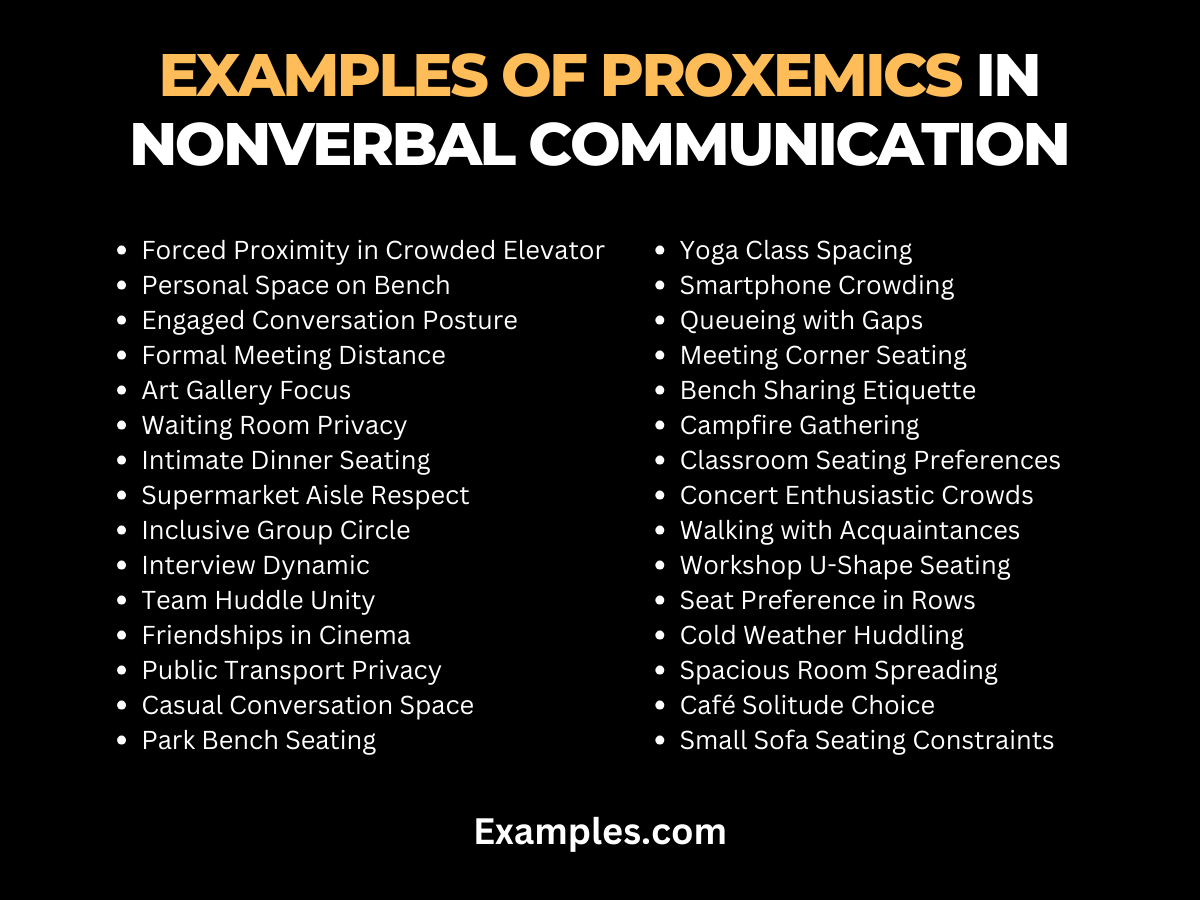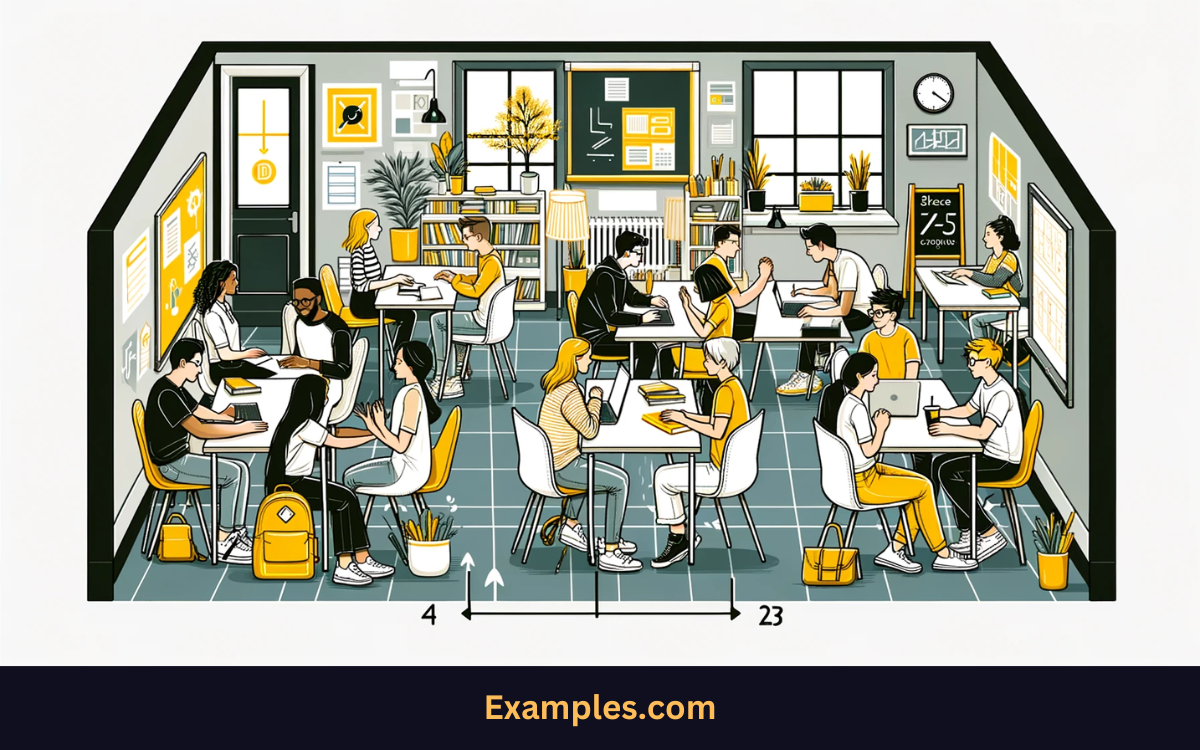Space (Proxemics) in Nonverbal Communication
Understanding Proxemics in Nonverbal Communication is crucial in deciphering the unspoken language of space. This comprehensive guide delves into how physical distance between individuals can communicate various messages, ranging from intimacy to authority. It’s a fascinating aspect of Nonverbal Communication Examples that influences our daily interactions, whether in personal relationships or professional settings. Learn how to read and use this silent yet powerful tool of communication to enhance your social skills and understand others better.
What is Proxemics in Nonverbal Communication?

Proxemics refers to the study of how space is used in Nonverbal Communication. It explores the distance between individuals during interactions and how this distance impacts communication. Understanding proxemics can reveal a lot about a person’s comfort level, intentions, and relationship with others. It’s a key component of Nonverbal Communication Examples that often goes unnoticed but plays a vital role in conveying messages without words.
What is the Best Example of Proxemics in Nonverbal Communication?

A classic example of Proxemics in Nonverbal Communication can be observed in different social settings. For instance, the distance maintained between two people during a casual conversation versus a formal meeting varies significantly. In casual settings, people tend to stand closer, indicating comfort and familiarity. In contrast, formal or professional interactions often involve more significant physical distances, signifying formality and a professional boundary. This use of space, whether intentional or subconscious, sends strong signals about the nature of the relationship and the context of the interaction, making it a pivotal aspect of Nonverbal Communication.
30 Examples of Space (Proxemics) in Nonverbal Communication

Understanding the role of space, or proxemics, in nonverbal communication is crucial. Space influences how we connect with others and conveys various unspoken messages. This article explores 30 distinct examples of space in nonverbal communication, each followed by a brief explanation and communicative sentences. These examples demonstrate the nuances and importance of space in conveying nonverbal cues in diverse contexts, from personal interactions to professional settings.
- Standing Close in a Crowded Elevator: Demonstrates necessity rather than intimacy.
Example: In a packed elevator, people stand close, but their body language remains neutral, indicating a forced proximity rather than a choice. - Sitting at Opposite Ends of a Bench: Indicates a desire for personal space.
Example: Two acquaintances sitting far apart on a bench show a preference for personal space, avoiding intimate conversation. - Leaning in During a Conversation: Suggests interest and engagement.
Example: Leaning in while someone speaks shows active engagement and interest in the conversation. - Maintaining Distance in a Formal Meeting: Reflects respect and professionalism.
Example: In a business meeting, participants maintain a respectful distance, indicating a professional relationship. - Standing Side-by-Side at an Art Gallery: Implies a shared focus, not intimacy.
Example: Visitors standing side-by-side at an art gallery are more focused on the artwork than on personal interaction. - Spacing Out Chairs in a Waiting Room: Ensures comfort and privacy.
Example: Chairs spaced out in a waiting room provide individuals with a sense of privacy and comfort.

- Close Proximity in a Romantic Dinner: Indicates intimacy and connection.
Example: Couples sitting closely at a romantic dinner use space to express intimacy and closeness. - Giving Wide Berth in a Supermarket Aisle: Shows respect for personal space.
Example: Shoppers giving each other wide berth in a supermarket aisle respect each other’s personal space. - Circle Formation in a Group Discussion: Fosters inclusivity and equality.
Example: A circle formation during a group discussion allows everyone to feel included and on equal footing. - Sitting Across from Each Other in an Interview: Establishes a formal dynamic.
Example: The interviewer and interviewee sitting across from each other create a formal and professional dynamic. - Gathering Closely During a Team Huddle: Builds a sense of team unity.
Example: Team members huddle closely to foster a sense of unity and shared purpose. - Choosing Adjacent Seats in a Cinema Among Friends: Reflects comfort and friendship.
Example: Friends choosing adjacent seats in a cinema demonstrates their comfort and camaraderie. - Keeping Distance in a Public Transport: Indicates a preference for privacy.
Example: Commuters keeping distance on public transport often indicate a preference for privacy over social interaction. - Standing at Arm’s Length in a Casual Conversation: Balances engagement and personal space.
Example: People conversing at arm’s length maintain a balance between engagement and respecting personal space. - Sitting Side-by-Side on a Park Bench: Can indicate comfort or mere coexistence.
Example: Individuals sitting side-by-side on a park bench might be comfortable with each other or simply coexisting in the same space. - Spacing Out in a Yoga Class: Ensures personal space and freedom of movement.
Example: Participants in a yoga class space out to ensure personal space and unhindered movement. - Crowding Around a Smartphone Screen: Shows shared interest and intimacy.
Example: Friends crowding around a smartphone screen indicate a shared interest and a comfortable intimacy. - Queueing With Gaps Between People: Reflects respect for personal space in public.
Example: People standing with gaps in a queue demonstrate respect for each other’s personal space.

- Sitting at the Corner of a Table in a Meeting: Can signal detachment or observation.
Example: Someone sitting at the corner of a table in a meeting may be observing or detaching themselves from the group dynamics. - Sharing a Bench with a Stranger: Requires respectful distance to be comfortable.
Example: Sharing a bench with a stranger typically involves maintaining a respectful distance for comfort. - Gathering Around a Campfire: Creates a sense of community and warmth.
Example: People gathered closely around a campfire exhibit a sense of community and shared warmth. - Occupying Alternate Seats in a Classroom: Indicates a preference for personal space.
Example: Students occupying alternate seats in a classroom show a preference for personal space. - Close Physical Proximity in a Concert: Reflects shared enthusiasm more than intimacy.
Example: The close proximity of people in a concert crowd is more about shared enthusiasm than personal intimacy. - Maintaining Distance While Walking with Acquaintances: Balances social interaction and personal space.
Example: Walking with acquaintances while maintaining a comfortable distance balances social interaction with personal space. - Sitting in a U-Shape in a Workshop: Facilitates interaction and visibility.
Example: Participants sitting in a U-shape in a workshop facilitates easy interaction and visibility for all. - Avoiding the Middle Seat in a Row: Shows a preference for easy access or privacy.
Example: Choosing an aisle or window seat over the middle one in a row can indicate a preference for easy access or privacy. - Huddling Together in Cold Weather: Suggests practical closeness for warmth.
Example: People huddling together in cold weather often do so for practical warmth, not necessarily intimacy. - Spreading Out in a Spacious Room: Utilizes available space for comfort.
Example: People naturally spread out in a spacious room to utilize the available space for personal comfort. - Choosing a Quiet Corner in a Café: Indicates a desire for solitude or focus.
Example: Someone choosing a quiet corner in a café likely seeks solitude or focus. - Sitting Closely on a Small Sofa: Necessitates closeness due to limited space.
Example: Sitting closely on a small sofa is often a necessity due to space constraints, rather than a choice for intimacy.
Examples of Proxemics in Nonverbal Communication in Workplace
Space or proxemics plays a crucial role in nonverbal communication within the workplace, influencing interactions and conveying unspoken messages. Understanding how physical space impacts communication helps in creating effective, respectful workplace dynamics. Here are ten unique examples illustrating this concept:
- Open vs. Closed Office Layout: In an open office, the lack of physical barriers signifies openness and collaboration. In contrast, closed offices imply privacy and hierarchy.
Example: “Our open-plan office encourages team interaction, fostering a collaborative environment.” - Personal Space during Meetings: Maintaining appropriate personal space in meetings indicates respect and professionalism.
Example: “By sitting at a comfortable distance during the meeting, I respect my colleagues’ personal space.” - Distance in Seating Arrangements: The distance between seats in a meeting room can affect the level of formality and intimacy of the conversation.
Example: “Placing chairs closer during team discussions fosters a more intimate and collaborative atmosphere.” - Standing Distance in Conversations: Standing too close can be intimidating, while too far may seem disinterested.
Example: “I maintain a respectful distance while conversing, balancing engagement with personal space.” - Use of Physical Barriers: Using objects like desks or computers to create a barrier can signal a need for focus or privacy.
Example: “Positioning my desk towards the door minimizes distractions and signals focus.” - Space Utilization in Presentations: Using space effectively during presentations can enhance communication and audience engagement.
Example: “I move around the room during my presentation to engage with the audience effectively.” - Positioning in Group Discussions: Where one sits in a group can indicate their role or level of engagement in the discussion.
Example: “Sitting at the head of the table, I lead the team meeting effectively.” - Respecting Colleagues’ Workspace: Acknowledging and respecting the physical workspace of others promotes a respectful work environment.
Example: “I always knock before entering a colleague’s office, respecting their space.” - Space in Social Interactions: Differentiating between professional and social interactions in the workplace can be indicated through proxemics.
Example: “At social events, I relax my space boundaries slightly to foster friendlier interactions.” - Hallway Conversations: The informal setting of a hallway conversation often involves closer proximity, reflecting a more relaxed interaction.
Example: “Our brief hallway chats are often closer and more informal than office meetings.”

Examples of Space in Nonverbal Communication for Students
In educational settings, space or proxemics significantly affects learning and interaction among students. It shapes classroom dynamics and reflects unspoken social cues. Here are ten examples demonstrating this concept in student environments:
- Seating Arrangement in Classrooms: How students choose to sit in a classroom can reflect their engagement levels and social preferences.
Example: “Sitting in the front row, I engage more actively in class discussions.” - Group Work Proxemics: The physical arrangement during group work can indicate collaboration levels and group dynamics.
Example: “By arranging our chairs in a circle, we facilitate better group communication.” - Personal Space in Libraries: Respecting personal space in quiet areas like libraries is crucial for a conducive study environment.
Example: “I keep a respectful distance in the library, allowing others their space to study.” - Physical Distance in Peer Interaction: Students often convey their social relationships through the physical distance they maintain with peers.
Example: “Sitting close to my friends at lunch, we share a comfortable and familiar space.” - Proximity in Sports and Activities: Physical closeness in sports and extracurricular activities can build teamwork and camaraderie.
Example: “During basketball practice, our close physical proximity helps build team unity.” - Use of Space in Performances: In drama or dance, students use space to convey emotions and narratives effectively.
Example: “Expanding my movements across the stage, I express the character’s emotions vividly.” - Classroom Design Impact: The design and layout of a classroom can affect student interaction and learning styles.
Example: “The U-shaped classroom layout facilitates better interaction with the teacher.” - Space in Laboratory Work: Proxemics in lab settings can influence collaboration and safety during experiments.
Example: “We maintain adequate space while conducting experiments for safety and efficiency.” - Hallway Dynamics Among Students: Hallways often serve as social spaces where students interact more freely and closely.
Example: “In the hallways, we gather closely, sharing stories and socializing between classes.” - Distance in Teacher-Student Interaction: The physical distance between teachers and students can reflect the formality of their relationship.
Example: “Maintaining a professional distance, the teacher addresses the class effectively.”

What are the Levels of Space or Proxemics in Nonverbal Communication?
Nonverbal communication plays a pivotal role in how we interact and understand each other. Among its various aspects, Space (Proxemics) in Nonverbal Communication is crucial for effective interactions. Proxemics refers to the use of space in communication and how it influences the way we perceive messages. Let’s delve into the levels of space in nonverbal communication, shedding light on how our physical distance impacts interactions.
Personal Space and Its Impact
Personal space, the physical distance we maintain in interactions, is not just a comfort preference but a form of nonverbal communication. This space varies depending on cultural norms, personal preferences, and the nature of the relationship. It can be broken down into four distinct zones:
- Intimate Space: Ranging up to 18 inches, this is the space for close, personal interactions. Typically reserved for loved ones, it’s where most Touch / Haptics in Nonverbal Communication occurs. The use of intimate space is culturally dependent and is where emotions are most intensely communicated.
- Personal Space: Extending from about 1.5 to 4 feet, this zone is used for interactions with friends and acquaintances. It’s a space where personal conversations occur, and the use of gestures and body language becomes more pronounced.
- Social Space: Spanning from 4 to 12 feet, this is the space for formal interactions, such as meetings or discussions with colleagues. In this zone, nonverbal cues like posture, attire, and Facial Expressions in Nonverbal Communication play significant roles.
- Public Space: Beyond 12 feet, this is the space for public speaking and larger gatherings. Nonverbal communication here is less about individual interactions and more about one’s overall presence and mannerisms.
Cultural Variations in Proxemics
Cultural differences greatly influence how space is perceived and used in communication. What is considered an appropriate distance in one culture might be seen as intrusive or distant in another. Understanding these differences is key to effective cross-cultural communication.
Role of Proxemics in Non-Verbal Communication
Proxemics, an essential aspect of non-verbal communication, significantly influences interactions in various settings, including technical communication. Understanding the role of proxemics can enhance the effectiveness of communication in professional environments.
Understanding Proxemics in Non-Verbal Communication
Proxemics refers to the use of space in communication. It is how individuals utilize physical space to convey messages and establish relationships. The concept of proxemics was introduced by Edward T. Hall, an American anthropologist, highlighting its importance in Nonverbal Communication. This aspect of communication involves various distances: intimate, personal, social, and public, each serving a distinct role in conveying messages and emotions.
Proxemics and Its Influence in Technical Communication
In the realm of technical communication, proxemics plays a vital role. It can affect how a message is received and interpreted. For instance, the distance maintained during a presentation or meeting can influence the audience’s engagement and understanding. Closer distances can foster a sense of intimacy and trust, while larger distances might convey formality or detachment.
Application of Proxemics in Workplace Environments
In a workplace setting, understanding and utilizing proxemics can enhance communication effectiveness. For example, in a team meeting, a leader might choose a closer physical distance to foster a sense of unity and collaboration. In contrast, during a formal presentation, maintaining a more considerable distance can establish authority and professionalism.
Proxemics and Cultural Sensitivity
It’s crucial to consider cultural differences in proxemics. Different cultures have varied norms regarding acceptable physical distance in communication. For example, what is considered a comfortable distance in one culture might be perceived as intrusive or distant in another. Being culturally sensitive in using space is a key aspect of effective Nonverbal Communication.
Proxemics in Virtual Environments
In today’s digital age, proxemics also extends to virtual environments. The way individuals position themselves in front of the camera during video conferences, the background chosen, and the space visible on the screen, all contribute to the non-verbal cues transmitted during virtual communication.
In conclusion, the exploration of Space (Proxemics) in Nonverbal Communication has revealed the profound impact of physical space on our daily interactions, both in personal and professional contexts. Proxemics, as an integral part of nonverbal communication, underscores the subtleties of human interactions and the unspoken messages conveyed through spatial choices.
- In personal relationships, the distance we maintain speaks volumes about our comfort levels, intentions, and the nature of our connections with others. This aspect becomes even more significant in cross-cultural interactions, where different norms regarding physical distance can lead to misunderstandings or profound insights into cultural values.
- In professional settings, proxemics takes on a critical role in shaping workplace dynamics. The spatial arrangements in meetings, presentations, and office layouts communicate hierarchy, collaboration, and the nature of professional relationships. Leaders and professionals can harness the power of proxemics to enhance teamwork, establish authority, and create a respectful, effective work environment.
For further reading on the nuances of proxemics in different cultural contexts, the article “Understanding Cultural Differences in Proxemics” from Psychology Today offers valuable insights. Additionally, for a deeper dive into the application of proxemics in virtual environments, the resource “Proxemics in the Digital Age: The New Norms of Personal Space” from Forbes provides a contemporary perspective on this evolving aspect of nonverbal communication.



